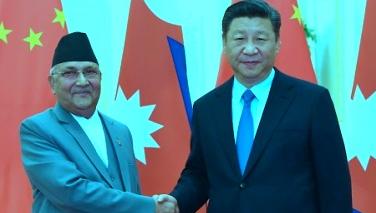Nepal Exerts ‘Indirect Effort’ to Play Anti-India Card
By :
Notice: Trying to get property 'fName' of non-object in /home/u589520015/domains/observerdawn.com/public_html/module/Application/view/application/index/news.phtml on line 23
Notice: Trying to get property 'lName' of non-object in /home/u589520015/domains/observerdawn.com/public_html/module/Application/view/application/index/news.phtml on line 23

Nepal
Prime Minister, KP Sharma Oli’s push to fast-track release of a new political
map is linked to his huge climb-down last month when he had to cancel an
ordinance within five days. There is an intensive effort by the Oli Government
in recent days to play the anti-India card to whip up ultra-nationalistic
emotions to settle domestic scores.
“By raising an ultra-nationalistic
sentiment, Oli has left his comrades - former PMs, Pushpa Kamal Dahal
‘Prachanda’ and Madhav Kumar Nepal - with no option but to side with him and
make India the casualty in the cross-firing between the two groups, a second person”,
an internal sources said.
Nepal’s new political map that claims the
Lipulekh Pass, Limpiyadhura and Kalapani in Uttarakhand’s Pithoragarh as its
own is only one part of this exercise. PM Oli’s statement in parliament on May
20, 2020, through which he claimed that the coronavirus infection was coming
from India appeared more lethal than those from China and Italy.
The two former Prime Ministers, who have
been accused of destabilizing the KP Sharma Oli-led government, are seen to
have played a lead role in the tug-of-war that played out in Nepal’s power
politics.
At a time when Nepal, like the rest of
the world was battling Covid-19, the prime minister had surprised his country
when he got twin ordinances notified. These two made it easier for the parties
to split and register a new faction.
These were widely perceived to be part of an exercise by PM Oli to
strengthen himself in the party and the government.
Oli stood down on April 23 and scrap the
ordinances within five days to buy peace with his prime detractors. The
Communist Party of China’s international liaison department also stepped up
efforts to broker peace between the comrades in Nepal, a media report from
Nepal reveals. It was this shade of domestic power play at work when land
management minister Padma Kumari Aryal held up a new map of Nepal.
“In a press conference, Padma K Aryal,
had hoped that India would take Nepal’s decision to publish the new map in a
positive way. She didn’t elaborate further”, a report in the Katmandu post
revealed. The 80-km stretch of road that New Delhi built Uttarakhand’s
Dharchula to Lipulekh to make it easier for pilgrims to reach Kailash
Mansarovar in the Tibet Autonomous Region offered the perfect opportunity.
Army Chief, Gen Manoj Mukund Naravane,
brushed aside the shrill voices from Kathmandu, underlining that there was no
dispute over the land on which the road had been built. He further went on to
suggest that the protests could be at the behest of someone else – an indirect
reference to China.
Prime Minister Oli, who is seen to be
heavily tilting towards China, has described Gen Naravane’s comment as
‘inappropriate.
Kalapani is a 35 square kilometer area in
Uttarakhand’s Pithoragarh district. Nepal claims this area as part of its
Darchula district. The tri-junction point of Lipulekh, Kalapani and
Limpiyadhura in Nepal’s northwest separates China and the Tibet Autonomous Region
to the north and India’s Kumaon to the south. The Mahakali river has been
considered as a natural demarcation line to separate the borders.
Indian security officials say China has
tacitly recognized India’s claim over the Kalapani area when it agreed to open
a border trade post at Lipulekh in 2015.
